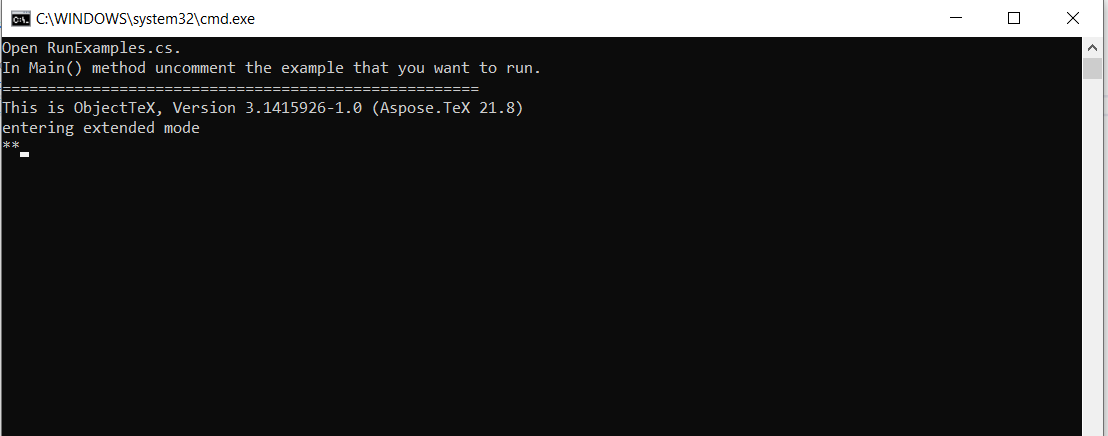Proporcionar el archivo de entrada TeX principal | .NET
Proporcionar el archivo de entrada principal al motor TeX como una secuencia
Hasta este punto, sólo sabíamos cómo pasar el
archivo de entrada principal al motor TeX como un nombre de archivo, ya sea completamente especificado o en formato corto, con o sin extensión. Pero hay otro
constructor de la clase TeXJob, que toma una secuencia como primer argumento. Esto es conveniente si por alguna razón tenemos el archivo de entrada principal en un formato que no sea un archivo en el sistema de archivos del disco. Así es como se puede implementar:
1// Stream input with LaTeX document and XPS output
2
3// Create conversion options for Object LaTeX format upon Object TeX engine extension.
4TeXOptions options = TeXOptions.ConsoleAppOptions(TeXConfig.ObjectLaTeX);
5
6// Specify a file system working directory for the output.
7options.OutputWorkingDirectory = new OutputFileSystemDirectory(OutputDir);
8
9// Specify the console as the output terminal.
10options.TerminalOut = new OutputConsoleTerminal();
11
12// Define the saving options.
13options.SaveOptions = new XpsSaveOptions();
14
15// Create the XPS device.
16XpsDevice device = new XpsDevice();
17
18// Run the job with LaTeX document from memory stream.
19TeXJob job = new TeXJob(new MemoryStream(Encoding.ASCII.GetBytes(
20 @"\documentclass{article} \begin{document} Hello, World! \end{document}")),
21 device, options);
22job.Run();
23
24// For further output to look fine.
25options.TerminalOut.Writer.WriteLine();Tenga en cuenta que todos los archivos de salida tendrán el nombre texput. Esto se debe a que el motor no puede recibir ningún otro nombre en ninguna parte. texput es el nombre del trabajo predeterminado. Aquí y aquí son detalles sobre los nombres de los trabajos.
Ingresando el archivo de entrada TeX principal desde la terminal
Hay otro
constructor de la clase TeXJob, que no nos permite especificar la entrada en absoluto. Entonces, ¿qué va a procesar un trabajo TeX de este tipo?, te preguntarás. Esta vez necesitaremos un terminal de entrada. El motor TeX nos pedirá que introduzcamos el nombre del archivo desde la terminal.
Aquí está el código:
1// Enter main TeX input file from the terminal (interactive)
2
3// Create conversion options for default ObjectTeX format upon ObjectTeX engine extension.
4TeXOptions options = TeXOptions.ConsoleAppOptions(TeXConfig.ObjectTeX());
5
6// Specify a file system working directory for the input.
7options.InputWorkingDirectory = new InputFileSystemDirectory(DataDir);
8
9// Specify a file system working directory for the output.
10options.OutputWorkingDirectory = new OutputFileSystemDirectory(OutputDir);
11
12// Specify the console as the output terminal.
13options.TerminalOut = new OutputConsoleTerminal();
14
15// Define the saving options.
16options.SaveOptions = new XpsSaveOptions();
17
18// Run the job. The TeX engine will ask to enter the file name from the terminal.
19// Note: This is an interactive example. In production, you would typically
20// provide input via TerminalIn property or use one of the other input methods.
21TeXJob job = new TeXJob(new XpsDevice(), options);
22job.Run();
23
24// For further output to look fine.
25options.TerminalOut.Writer.WriteLine();Tan pronto como se ejecuta, el motor se queda esperando a que introduzcamos el nombre del archivo (con o sin ruta, con o sin extensión):

Y así quedaría en el terminal de salida que es la consola:
1This is ObjectTeX, Version 3.1415926-1.0 (Aspose.TeX 21.8)
2entering extended mode
3**<path_to_the_file>/hello-world.ltx
4(<path_to_the_file>/hello-world.ltx
5LaTeX2e <2011/06/27>
6(article.cls
7Document Class: article 2007/10/19 v1.4h Standard LaTeX document class
8(size10.clo))
9No file hello-world.aux.
10[1]
11(<output_directory>\hello-world.aux) )
12Output written on hello-world.xps (1 page).
13Transcript written on hello-world.log.